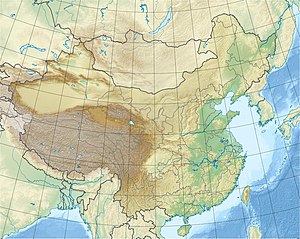Emei Shan
| Emei Shan 峨眉山 |
||
|---|---|---|
|
Summit of Emei Shan |
||
| height | 3099 m | |
| location | Sichuan , China | |
| Coordinates | 29 ° 30 '36 " N , 103 ° 19' 54" E | |
|
|
||
| Development | Cable car, road | |
The Emei Shan ( Chinese 峨嵋山 / 峨眉山 , Pinyin Éméi Shān , W.-G. O-mei Shan - "towering eyebrow mountain") is one of the four sacred Buddhist mountains in China . At a height of 3,099 meters, it rises from the basin of the Sichuan province . He is eponymous for the Emeishan Trapp .
According to one theory, the name eyebrow mountain comes from the elongated shape of the ridge. In 1996 it was added to the list of UNESCO World Heritage Sites together with nearby Leshan . The temples on the Emei Shan ( Chinese 峨嵋山 古 建築 群 / 峨眉山 古 建筑 群 , Pinyin Éméi Shān Gǔ Jiànzhùqún ) are on the list of monuments of the People's Republic of China .
Attractions
The legend of the Buddhist mountain says that the Bodhisattva Samantabhadra ( Chinese普賢 / 普贤Pinyin Pǔxián; Japanese ふ げ ん / 普賢 , fugue ) flew up the mountain on his white three-headed elephant. Therefore, the mountain is seen as his abode or at least associated with it. In Wànnián-Sì (the 10,000-year-old temple), the oldest still existing temple on the mountain, reconstructed in the 9th century, there is a 7.35 meter high statue of the Bodhisattva on his elephant, erected in 980. It is said to bring good luck to stroke the elephant's flanks.
Most of the more than a hundred temples on the mountain fell victim to the Cultural Revolution . About two dozen temples have been active again since then, but most of them, reconstructed after the Cultural Revolution, are in poor condition, while a few that have been preserved continue to display their old glory. Some earn extra income by renting out rooms to tourists and pilgrims. The Jīndǐng-Sì (Golden Summit Temple) at the peak traditionally held for the peak at an altitude of 3,077 meters has been completely reconstructed and requires entry.
Bàoguó Sì ( Baoguo Temple )
The mountain has allegedly been the destination of Buddhist pilgrims since the 6th century. After the cultural revolution and with the rapid increase in domestic tourism in recent years, the number of visitors has increased again dramatically. The ascent on foot, via two different routes (traditionally one was used for the ascent and one for the descent), takes between two and three days. The paths consist almost entirely of steps. They are less overcrowded than one might assume, as a newly built road also allows motorized traffic almost to the summit, where you suddenly come across huge crowds, shops and parking lots. There is a fee to visit the mountain.
The mountain is famous for its views and the sight of the sunrise, but mostly obscured by fog and clouds. From the summit you can sometimes see rainbow-like reflections on the clouds below when the cloud cover is lower. Some Buddhists regarded this phenomenon as a pure land , into which so many people tried to jump down that barriers were erected as a countermeasure as early as the Ming Dynasty .
Samantabhadra statue on the Gold Summit
A 48-meter-high statue representing Samantabhadra was erected at the top of the gold. It is made of copper, is covered with gold and is considered the largest golden Buddha statue in the world. The figure measures 42 meters with a base that is around 6 meters higher. The total height of 48 meters represents the 48 vows of Amitābha . Inside the statue is a temple.
Flora and fauna
Tibetan macaques are common on the mountain . Especially at the summit, these monkeys have become so used to the food donations from visitors (which are also considered to be Buddhist earnings) that they sometimes very aggressively demand their rights. Special guards are therefore employed at the summit to hold the monkeys back a little. Further examples of endemic animal species are the Anderson shrew mole , the frog species Rana adenopleura , the Asian toad frog species Leptobrachium liui and the giant earthworm species Pheretima praepinguis .
The area around the Emei Shan is also botanically remarkable, as a number of locally endemic species occur here. The holly species Ilex omeiensis Hu & Tang thrives in mixed forests and on mountain slopes at altitudes of 500 to 1800 meters. The Helmkrautart Scutellaria mollifolia CYWu & HWLi in shady spots in woods in altitude. The Solomon's seal species Polygonatum omeiense ZYZhu: This endemic thrives on wooded slopes at altitudes of around 1800 meters. The liverwort species Hepatica henryi (olive) Steward and the fir species Abies fabri ( mast. ) Craib are also endemic to Emei Shan .
See also
Web links
- Entry on the UNESCO World Heritage Center website ( English and French ).
- Emei Shan at Sacred Destinations (English)
Individual evidence
- ↑ UNESCO World Heritage Center: Mount Emei Scenic Area, including Leshan Giant Buddha Scenic Area. Accessed August 17, 2017 .
- ↑ aleriamay.wordpress.com: What is the giant golden Buddha doing on top of Emei Mountain? https://en.wikipedia.org/wiki/Wannian_Temple_%28Mount_Emei%29
- ↑ a b Emei Mountain. Retrieved May 16, 2011 .
- ^ The saint statue of Shifang Puxian. Retrieved May 16, 2011 .
- ↑ Emei Mountain. Retrieved May 16, 2011 .








